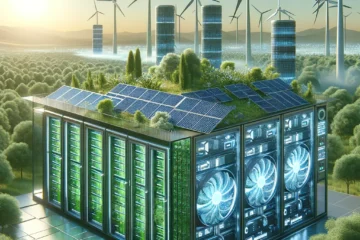As the digital age continues to expand, so does the energy footprint of the data centers that power our online lives. But in the face of climate change, these digital fortresses have started to turn a new leaf, sparking a revolution aptly dubbed ‘Green Computing.’ From Silicon Valley to Singapore, data centers are now embracing sustainability, proving that we can save bytes and the planet simultaneously. Let’s dive into this verdant virtual landscape where the future is not just bright; it’s green!
Eco-Servers: The Future is Green!
In the heart of every data center, servers hum with the pulse of processed information. But the eco-servers of tomorrow sing a different tune—one of energy efficiency and reduced emissions. These innovative machines are designed to do more with less, consuming a fraction of the power of their predecessors while delivering lightning-fast performance. As we march toward a sustainable future, eco-servers stand on the front lines, proving that green technology can coexist with cutting-edge computing.
Watt’s Up in Green Data Centers
What’s the buzz in the world of green data centers? Watts—and fewer of them! Energy efficiency is now the currency of this new digital economy. Builders and operators are implementing advanced power management systems, ditching the old power-hungry equipment, and even using AI to optimize energy use. Every watt saved is a victory in the battle against climate change, and green data centers are leading the charge with their newfound electrical frugality.
Clouds Now Greener Than Ever!
Looking up at the data clouds, we now see a shade of emerald. Cloud computing, the backbone of the internet, has shifted gears toward sustainability. Companies are sourcing cleaner energy to keep their clouds afloat, and customers are taking note. Transparent reporting on carbon footprints allows businesses to choose greener cloud services, making sustainability a competitive advantage. The clouds may be virtual, but their positive impact on the environment is as real as it gets.
Cool Computing: Low-Carbon Footprint
Keeping servers cool traditionally meant cranking up the air conditioning, but now, innovative cooling technologies are making a splash. From using outside air to implementing liquid cooling solutions, data centers are lowering their carbon footprint without breaking a sweat. These cool computing strategies not only reduce greenhouse gas emissions but also bolster the servers’ performance, making them eco-friendly and effective.
Renewable Bytes: Power to Change
It’s not just about using less energy; it’s about where that energy comes from. Renewable bytes are the currency of change in green data centers, with wind, solar, and hydroelectric power providing a clean, inexhaustible supply. Companies are investing heavily in renewable energy, buying into wind farms, and installing solar panels on vast stretches of rooftops. With every kilowatt-hour sourced from renewables, data centers are helping to power a brighter, cleaner future.
Green Gigabytes: The New Norm
Gone are the days when green computing was a niche concept. Green gigabytes are now the industry standard, with environmental sustainability becoming a core criterion for both customers and providers. As green initiatives become more robust and widespread, data centers are showcasing that technology and the environment can grow hand in hand. In this new digital ecosystem, green gigabytes not only drive innovation but also foster a harmonious relationship with our planet.
As we power down this exploration of green data centers, it’s clear that the industry’s transformation is well underway. The commitment to sustainability is not just a trend—it’s an essential evolution in our journey towards a digitized, yet conscientious, future. The green data centers of today are setting a precedent for all technology sectors, proving that with innovation and determination, we can indeed save bytes and the planet. Let’s continue to cheer on these champions of change, for in their circuits and systems lies the promise of a greener tomorrow.




